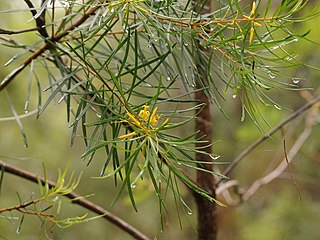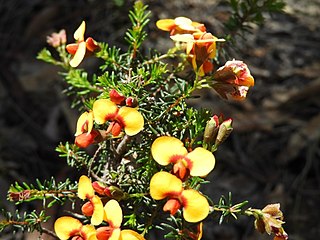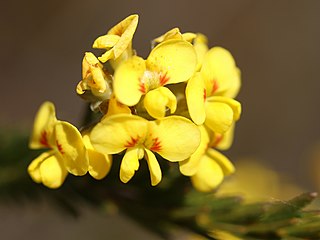
Dillwynia tenuifolia is a species of flowering plant in the family Fabaceae and is endemic to eastern New South Wales. It is an erect shrub with linear leaves, and orange-yellow and red flowers.

Dillwynia cinerascens, commonly known as grey parrot-pea, is a species of flowering plant in the family Fabaceae and is endemic to south-eastern Australia. It is an erect to low-lying shrub with linear or thread-like leaves and orange or yellow flowers.

Dillwynia floribunda is a species of flowering plant in the family Fabaceae and is endemic to eastern Australia. It is an erect shrub with hairy stems, crowded, grooved, linear leaves and yellow flowers with red markings.

Persoonia virgata is a species of flowering plant in the family Proteaceae and is endemic to coastal areas of eastern Australia. It is usually an erect shrub with smooth bark, hairy young branchlets, linear to narrow spatula-shaped leaves, and yellow flowers borne in groups of up to seventy-five on a rachis up to 230 mm (9.1 in) long that continues to grow after flowering.

Dillwynia phylicoides, commonly known as small-leaf parrot-pea, is a species of flowering plant in the family Fabaceae and is endemic to eastern Australia. It is an erect to open shrub with twisted, linear to narrow oblong leaves, and yellow and red flowers.

Cassinia longifolia, commonly known as shiny cassinia, is a species of flowering plant in the family Asteraceae and is endemic to eastern Australia. It is an erect, aromatic shrub with sticky, hairy foliage, linear or oblong to narrow lance-shaped leaves, and heads of creamy-white flowers arranged in a dense corymb.

Bossiaea rupicola is a species of flowering plant in the family Fabaceae and is endemic to eastern Australia. It is an erect shrub or small tree with silky-hairy, narrow egg-shaped to narrow elliptic leaves and red flowers with yellow markings.

Dillwynia elegans is a species of flowering plant in the family Fabaceae and is endemic to eastern New South Wales. It is an erect shrub with more or less cylindrical, grooved leaves and yellow flowers with red markings.

Dillwynia crispii is a species of flowering plant in the family Fabaceae and is endemic to Morton National Park in eastern New South Wales. It is an erect shrub with glabrous, linear leaves and yellow flowers with red markings.

Dillwynia glaucula, commonly known as Michelago parrot-pea, is a species of flowering plant in the family Fabaceae and is endemic to south-eastern New South Wales. It is an erect shrub with lenticels on the stems, linear, grooved leaves and yellow flowers with red markings.

Dillwynia hispida , commonly known as red parrot-pea, is a species of flowering plant in the family Fabaceae and is endemic to south-eastern Australia. It is an erect shrub with more or less glabrous stems, linear to thread-like leaves and orange and red, partly crimson flowers.

Dillwynia oreodoxa is a species of flowering plant in the family Fabaceae and is endemic to Victoria, Australia. It is an erect shrub with glabrous foliage, linear leaves and yellow flowers with red markings.
Dillwynia parvifolia is a species of flowering plant in the family Fabaceae and is endemic to New South Wales. It is a spreading to erect shrub with twisted, narrow oblong leaves and yellow flowers with red markings.

Dillwynia prostrata, commonly known as matted parrot-pea, is a species of flowering plant in the family Fabaceae and is endemic to south-eastern continental Australia. It is a prostrate shrub with hairy stems, linear to narrow oblong or spatula-shaped leaves and yellow and dark red flowers.

Dillwynia rudis is a species of flowering plant in the family Fabaceae and is endemic to eastern New South Wales. It is an erect shrub with warty, linear leaves and yellow to orange flowers with red veins.
Dillwynia rupestris is a species of flowering plant in the family Fabaceae and is endemic to the Gibraltar Range National Park in New South Wales. It is an erect, single-stemmed shrub with linear leaves and yellow flowers with red markings.
Dillwynia stipulifera is a species of flowering plant in the family Fabaceae and is endemic to New South Wales. It is an erect to spreading shrub with hairy stems, linear leaves and yellow flowers with red markings.

Pultenaea altissima, commonly known as tall bush-pea, is a species of flowering plant in the family Fabaceae and is endemic to south-eastern continental Australia. It is an erect shrub with spatula-shaped to egg-shaped leaves and yellow flowers in clusters at the ends of branches.

Pultenaea cinerascens is a species of flowering plant in the family Fabaceae and is endemic to central New South Wales. It is an erect to spreading shrub with narrow oblong to wedge-shaped leaves, and groups of yellow and red flowers.

Bossiaea concolor is a species of flowering plant in the family Fabaceae and is endemic to eastern Australia. It is an erect shrub with elliptic to oblong or egg-shaped leaves with the lower end towards the base, and yellow and red flowers.

















